Ecosystem and Driving Force Evaluation of Northeast Forest Belt
Abstract
:1. Introduction
2. Materials and Methods
2.1. Study Area
2.2. Data Source and Processing
2.3. Methods
2.3.1. Construction of Ecosystem Comprehensive Evaluation Index
2.3.2. Ecosystem Service
2.3.3. Ecosystem Quality
2.3.4. Evolution of Ecosystem Pattern
2.3.5. Quantitative Spatio-Temporal Analysis of EQ
2.3.6. Ecosystem Driving Force Analysis
3. Results and Analysis
3.1. Evolution of Ecosystem Pattern
3.2. Spatial Patterns and Variation of EQ
3.2.1. Dynamic Characteristics of NPP
3.2.2. Dynamic Characteristics of LAI
3.2.3. Dynamic Characteristics of FVC
3.3. Spatial Patterns and Variation of ES
3.3.1. Habitat Provision Service
3.3.2. Soil Conservation Service
3.3.3. Carbon Sequestration Service
3.3.4. Sand-Stabilization Service
3.3.5. Water Conservation Service
3.4. Comprehensive Ecosystem Index Evaluation
3.5. Driving Force Analysis
4. Discussion
4.1. Advantages of the Integrated Ecosystem Assessment Index
4.2. Uncertainty of Driving Force Analysis
4.3. Limitations of Current Research
5. Conclusions
Author Contributions
Funding
Institutional Review Board Statement
Informed Consent Statement
Data Availability Statement
Conflicts of Interest
References
- Sun, B. Decade Change of Ecosystem Pattern, Quality, Service Function and Stress in the Northeastern Forest Regions (2000–2010); University of Chinese Academy of Sciences: Beijing, China, 2015. [Google Scholar]
- Sun, B.; Zhao, H.; Lu, F.; Wang, X. Spatial and temporal patterns of carbon sequestration in the Northeastern Forest Regions and its impact factors analysis. Acta Ecol. Sin. 2018, 38, 4975–4983. [Google Scholar]
- Su, K.; Wang, Y.; Sun, X.; Yue, D. Landscape pattern change and prediction of Northeast Forest Belt based on GIS and RS. Trans. Chin. Soc. Agric. Mach. 2019, 50, 195–204. [Google Scholar]
- Kong, L.; Zhang, L.; Zheng, H.; Xu, W.; Xiao, Y.; Ouyang, Z. Driving forces behind ecosystem spatial changes in the Yangtze River Basin. Acta Ecol. Sin. 2018, 38, 741–749. [Google Scholar]
- Borzì, L.; Anfuso, G.; Manno, G.; Distefano, S.; Urso, S.; Chiarella, D.; Di Stefano, A. Shoreline evolution and environmental changes at the NW Area of the Gulf of Gela (Sicily, Italy). Land 2021, 10, 1034. [Google Scholar] [CrossRef]
- Aho, K.; Weaver, T. Alpine nodal ecology and ecosystem evolution in the North-Central Rockies (Mount Washburn; Yellowstone National Park, Wyoming). Arct. Antarct. Alp. Res. 2010, 42, 139–151. [Google Scholar] [CrossRef]
- Huang, J.; Sun, L.; Wang, X.; Wang, Y.; Huang, T. Ecosystem evolution of seal colony and the influencing factors in the 20th century on Fildes Peninsula, West Antarctica. J. Environ. Sci. 2011, 23, 1431–1436. [Google Scholar] [CrossRef]
- Li, C.; Zhao, J.; Zhuang, Z.; Gu, S. Spatiotemporal dynamics and influencing factors of ecosystem service trade-offs in the Yangtze River Delta urban agglomeration. Acta Ecol. Sin. 2022, 14, 1–13. [Google Scholar]
- Apostolopoulos, D.N.; Avramidis, P.; Nikolakopoulos, K.G. Estimating quantitative morphometric parameters and spatiotemporal evolution of the Prokopos Lagoon using remote sensing techniques. J. Mar. Sci. Eng. 2022, 10, 931. [Google Scholar] [CrossRef]
- Weng, H.; Gao, Y.; Su, X.; Yang, X.; Cheng, F.; Ma, R.; Liu, Y.; Zhang, W.; Zheng, L. Spatial-temporal changes and driving force analysis of green space in coastal cities of Southeast China over the past 20 years. Land 2021, 10, 537. [Google Scholar] [CrossRef]
- Qi, L.; Zhang, Y.; Xu, D.; Zhu, Q.; Zhou, W.; Zhou, L.; Wang, Q.; Yu, D. Trade-offs and synergies of ecosystem services in forest barrier belt of Northeast China. Chin. J. Ecol. 2021, 40, 3401–3411. [Google Scholar] [CrossRef]
- Zhu, Q.; Wang, Y.; Zhou, W.; Zhou, L.; Yu, D.; Qi, L. Spatiotemporal changes and driving factors of ecological vulnerability in Northeast China forest belt. Chin. J. Ecol. 2021, 40, 3474–3482. [Google Scholar] [CrossRef]
- Liang, B.; Shi, P.; Wang, W.; Tang, X.; Zhou, W.; Jing, Y. Integrated assessment of ecosystem quality of arid inland river basin based on RS and GIS: A case study on Shiyang River Basin, Northwest China. Chin. J. Appl. Ecol. 2017, 28, 199–209. [Google Scholar] [CrossRef]
- Zewdie, W.; Csaplovics, E. Identifying categorical land use transition and land degradation in northwestern drylands of Ethiopia. Remote Sens. 2016, 8, 408. [Google Scholar] [CrossRef]
- Foroumandi, E.; Nourani, V.; Dąbrowska, D.; Kantoush, S.A. Linking spatial-temporal changes of vegetation cover with hydroclimatological variables in terrestrial environments with a focus on the Lake Urmia Basin. Land 2022, 11, 115. [Google Scholar] [CrossRef]
- Gao, Z.; Bai, Y.; Zhou, L.; Qiao, F.; Song, L.; Chen, X. Characteristics and driving forces of wetland landscape pattern evolution of the city belt along the Yellow River in Ningxia, China. Chin. J. Appl. Ecol. 2020, 31, 3499–3508. [Google Scholar] [CrossRef]
- Karimi, F.M.; Majid, K.; Mehdi, H.; Jokar, A.J.; Kazem, A.S. A novel method to quantify urban surface ecological poorness zone: A case study of several European cities. Sci. Total Environ. 2021, 757, 143755. [Google Scholar]
- Mohammad, K.F.; Solmaz, F.; Majid, K.; Asim, B.; Mehdi, H.; Kazem, A.S. Land surface ecological status composition index (LSESCI): A novel remote sensing-based technique for modeling land surface ecological status. Ecol. Indic. 2021, 123, 107375. [Google Scholar]
- Sajjad, K.S.; Solmaz, A.; Mostafa, G. Spatiotemporal ecological quality assessment of metropolitan cities: A case study of central Iran. Environ. Monit. Assess. 2021, 193, 305. [Google Scholar]
- Maity, S.; Das, S.; Pattanayak, J.M.; Bera, B.; Shit, K.P. Assessment of ecological environment quality in Kolkata urban agglomeration, India. Urban Ecosyst. 2022, 25, 3. [Google Scholar] [CrossRef]
- Xu, H. A remote sensing index for assessment of regional ecological changes. China Environ. Sci. 2013, 33, 889–897. [Google Scholar]
- Xu, H.; Wang, Y.; Guan, H.; Shi, T.; Hu, X. Detecting ecological changes with a remote sensing based ecological Index (RSEI) produced time series and change vector analysis. Remote Sens. 2019, 11, 2345. [Google Scholar] [CrossRef]
- Yuan, B.; Fu, L.; Zou, Y.; Zhang, S.; Chen, X.; Li, F.; Deng, Z.; Xie, Y. Spatiotemporal change detection of ecological quality and the associated affecting factors in Dongting Lake Basin, based on RSEI. J. Clean. Prod. 2021, 302, 126995. [Google Scholar] [CrossRef]
- Wang, J. Study on the Spatiotemporal Changes of Ecological Environment and Land Use in the Central Area of Urumqi; Xinjiang University: Urumqi, China, 2021. [Google Scholar]
- Hu, X.; Xu, H. A new remote sensing index for assessing the spatial heterogeneity in urban ecological quality: A case from Fuzhou City, China. Ecol. Indic. 2018, 89, 11–21. [Google Scholar] [CrossRef]
- Boori, M.S.; Choudhary, K.; Paringer, R.; Kupriyanov, A. Spatiotemporal ecological vulnerability analysis with statistical correlation based on satellite remote sensing in Samara, Russia. J. Environ. Manag. 2021, 285, 112138. [Google Scholar] [CrossRef]
- Thiesen, T.; Bhat, M.G.; Liu, H.; Rovira, R. An ecosystem service approach to assessing agro-ecosystems in urban landscapes. Land 2022, 11, 469. [Google Scholar] [CrossRef]
- Chen, Q.; Chen, Y.; Wang, M.; Jiang, W.; Hou, Y.; Li, Y. Ecosystem quality comprehensive evaluation and change analysis of Dongting Lake in 2001—2010 based on remote sensing. Acta Ecol. Sin. 2015, 35, 4347–4356. [Google Scholar]
- Chen, H. Establishment and application of wetlands ecosystem services and sustainable ecological evaluation indicators. Water 2017, 9, 197. [Google Scholar] [CrossRef]
- Yilmaz, F.C.; Zengin, M.; Cure, C.T. Determination of ecologically sensitive areas in Denizli province using geographic information systems (GIS) and analytical hierarchy process (AHP). Environ. Monit. Assess. 2020, 192, 589. [Google Scholar] [CrossRef]
- Li, W.; Sun, B.; Wang, R.; Cui, L.; Ma, Q.; Zhang, M.; Lei, Y.; Zhu, Y. Various beneficiaries-based analysis on service weight of ecosystem of Momoge Wetland. Water Resour. Hydropower Eng. 2017, 48, 10–15. [Google Scholar] [CrossRef]
- Morandi, D.T.; França, L.C.d.J.; Menezes, E.S.; Machado, E.L.M.; Silva, M.D.d.; Mucida, D.P. Delimitation of ecological corridors between conservation units in the Brazilian Cerrado using a GIS and AHP approach. Ecol. Indic. 2020, 115, 106440. [Google Scholar] [CrossRef]
- Zhang, R.; Zhang, X.; Yang, J.; Yuan, H. Wetland ecosystem stability evaluation by using analytical hierarchy process (AHP) approach in Yinchuan Plain, China. Math. Comput. Model. 2013, 57, 366–374. [Google Scholar] [CrossRef]
- Shafaghat, A.; Ying, O.J.; Keyvanfar, A.; Jamshidnezhad, A.; Ferwati, M.S.; Ahmad, H.; Mohamad, S.; Khorami, M. A treatment wetland park assessment model for evaluating urban ecosystem stability using analytical hierarchy process (AHP). J. Environ. Treat. Tech. 2019, 7, 81–91. [Google Scholar]
- Guo, Z.; Wei, W.; Pang, S.; Li, Z.; Zhou, J.; Jie, B. Spatio-temporal evolution and motivation analysis of ecological vulnerability in Arid Inland River Basin based on SPCA and remote sensing index: A case study on the Shiyang River Basin. Acta Ecol. Sin. 2019, 39, 2558–2572. [Google Scholar]
- Chi, W.; Bai, W.; Liu, Z.; Dang, X.; Kuang, W. Wind Erosion in Inner Mongolia Plateau Using the Revised Wind Erosion Equation. Ecol. Environ. Sci. 2018, 27, 1024–1033. [Google Scholar] [CrossRef]
- Kong, L.; Zheng, H.; Rao, E.; Xiao, Y.; Ouyang, Z.; Li, C. Evaluating indirect and direct effects of eco-restoration policy on soil conservation service in Yangtze River Basin. Sci. Total Environ. 2018, 631–632, 887–894. [Google Scholar] [CrossRef]
- Fang, Q.; Wang, G.; Zhang, S.; Peng, Y.; Xue, B.; Cao, Y.; Shrestha, S. A novel ecohydrological model by capturing variations in climate change and vegetation coverage in a semi-arid region of China. Environ. Res. 2022, 211, 113085. [Google Scholar] [CrossRef] [PubMed]
- Deng, Y.; Yao, S.; Hou, M.; Zhang, T.; Lu, Y.; Gong, Z.; Wang, Y. Assessing the effects of the Green for Grain Program on ecosystem carbon storage service by linking the InVEST and FLUS models: A case study of Zichang county in hilly and gully region of Loess Plateau. J. Nat. Resour. 2020, 35, 826–844. [Google Scholar]
- Nie, Q.; Xu, J.; Ji, M.; Cao, L.; Yang, Y.; Hong, Y. The vegetation coverage dynamic coupling with climatic factors in Northeast China Transect. Environ. Manag. 2012, 50, 405–417. [Google Scholar] [CrossRef]
- Potter, C.S.; Randerson, J.T.; Field, C.B.; Matson, P.A.; Vitousek, P.M.; Mooney, H.A.; Klooster, S.A. Terrestrial ecosystem production: A process model based on global satellite and surface data. Glob. Biogeochem. Cycles 1993, 7, 811–841. [Google Scholar] [CrossRef]
- Berdjour, A.; Dugje, I.Y.; Rahman, N.A.; Odoom, D.A.; Kamara, A.Y.; Ajala, S. Direct estimation of maize leaf area index as influenced by organic and inorganic fertilizer rates in Guinea Savanna. J. Agric. Sci. 2020, 12, 66. [Google Scholar] [CrossRef]
- Zhuo, J.; Zhu, Y.; He, H.; Wang, J.; Dong, J.; Quan, W. Impacts of ecological restoration projects on the ecosystem in the Loess Plateau. Acta Ecol. Sin. 2020, 40, 8627–8637. [Google Scholar]
- Rotich, B.; Kindu, M.; Kipkulei, H.; Kibet, S.; Ojwang, D. Impact of land use/land cover changes on ecosystem service values in the cherangany hills water tower, Kenya. Environ. Chall. 2022, 8, 100576. [Google Scholar] [CrossRef]
- Nuppenau, E.-A. Soil fertility management by transition matrices and crop rotation: On spatial and dynamic aspects in programming of ecosystem services. Sustainability 2018, 10, 2213. [Google Scholar] [CrossRef]
- Müller, F.; Bicking, S.; Ahrendt, K.; Kinh Bac, D.; Blindow, I.; Fürst, C.; Haase, P.; Kruse, M.; Kruse, T.; Ma, L.; et al. Assessing ecosystem service potentials to evaluate terrestrial, coastal and marine ecosystem types in Northern Germany–An expert-based matrix approach. Ecol. Indic. 2020, 112, 106116. [Google Scholar] [CrossRef]
- Su, K.; Sun, X.; Wang, Y.; Chen, L.; Yue, D. Spatial and temporal variations of ecosystem patterns in Northern Sand Control Barrier Belt based on GIS and RS. Trans. Chin. Soc. Agric. Mach. 2020, 51, 226–236. [Google Scholar]
- Su, K.; Liu, H.; Wang, H. Spatial–temporal changes and driving force analysis of ecosystems in the Loess Plateau Ecological Screen. Forests 2022, 13, 54. [Google Scholar] [CrossRef]
- Ouyang, Z.; Zheng, H.; Xie, G.; Yang, W.; Liu, G.; Shi, Y.; Yang, D. Accounting theories and technologies for ecological assets, ecological compensation and scientific and technological contribution to ecological civilization. Acta Ecol. Sin. 2016, 36, 7136–7139. [Google Scholar]
- Wang, J.; Xu, C. Geodetector: Principle and prospective. Acta Geogr. Sin. 2017, 72, 116–134. [Google Scholar]
- Zhang, Z.; Song, Y.; Wu, P. Robust geographical detector. Int. J. Appl. Earth Obs. Geoinf. 2022, 109, 102782. [Google Scholar] [CrossRef]
- Bai, L.; Jiang, L.; Yang, D.; Liu, Y. Quantifying the spatial heterogeneity influences of natural and socioeconomic factors and their interactions on air pollution using the geographical detector method: A case study of the Yangtze River Economic Belt, China. J. Clean. Prod. 2019, 232, 692–704. [Google Scholar] [CrossRef]
- Ji, J.; Wang, S.; Zhou, Y.; Liu, W.; Wang, L. Studying the eco-environmental quality variations of Jing-Jin-Ji urban agglomeration and its driving factors in different ecosystem service regions from 2001 to 2015. IEEE Access 2020, 8, 154940–154952. [Google Scholar] [CrossRef]
- Li, H.; Wang, J.; Zhang, J.; Qin, F.; Hu, J.; Zhou, Z. Analysis of characteristics and driving factors of wetland landscape pattern change in Henan Province from 1980 to 2015. Land 2021, 10, 564. [Google Scholar] [CrossRef]
- Polykretis, C.; Grillakis, M.G.; Argyriou, A.V.; Papadopoulos, N.; Alexakis, D.D. Integrating multivariate (GeoDetector) and bivariate (IV) statistics for hybrid landslide susceptibility modeling: A Case of the vicinity of Pinios Artificial Lake, Ilia, Greece. Land 2021, 10, 973. [Google Scholar] [CrossRef]
- Mavhura, E.; Manyangadze, T. A comprehensive spatial analysis of social vulnerability to natural hazards in Zimbabwe: Driving factors and policy implications. Int. J. Disaster Risk Reduct. 2021, 56, 102139. [Google Scholar] [CrossRef]
- Uddin, M.N.; Saiful Islam, A.K.M.; Bala, S.K.; Islam, G.M.T.; Adhikary, S.; Saha, D.; Haque, S.; Fahad, M.G.R.; Akter, R. Mapping of climate vulnerability of the coastal region of Bangladesh using principal component analysis. Appl. Geogr. 2019, 102, 47–57. [Google Scholar] [CrossRef]
- Zhang, H.; Yu, D.; Yang, H. Quantitative evaluation of ecological environment improvement in Saihanba based on principal component analysis. Int. Core J. Eng. 2022, 8, 608–615. [Google Scholar]
- Liu, Y.; Dang, C.; Yue, H.; Lv, C.; Qian, J.; Zhu, R. Comparison between modified remote sensing ecological index and RSEI. Natl. Remote Sens. Bull. 2022, 26, 683–697. [Google Scholar]
- Li, Y.; Zhang, G.; Lin, T.; Ye, H.; Liu, Y.; Chen, T.; Liu, W. The spatiotemporal changes of remote sensing ecological index in towns and the influencing factors: A case study of Jizhou District, Tianjin. Acta Ecol. Sin. 2022, 42, 474–486. [Google Scholar]
- Wang, X.; Lesi, M.C.; Zhang, M. Ecosystem pattern change and its influencing factors of “two barriers and three belts”. Chin. J. Ecol. 2019, 38, 2138–2148. [Google Scholar] [CrossRef]
- Zhang, H.; Fan, J.; Shao, Q.; Zhang, Y. Ecosystem dynamics in the ’Returning Rangeland to Grassland’ programs, China. Acta Prataculturae Sin. 2016, 25, 1–15. [Google Scholar]
- Wang, J.; Peng, J.; Zhao, M.; Liu, Y.; Chen, Y. Significant trade-off for the impact of Grain-for-Green Programme on ecosystem services in North-western Yunnan, China. Sci. Total Environ. 2017, 574, 57–64. [Google Scholar] [CrossRef]
- Jia, X.; Fu, B.; Feng, X.; Hou, G.; Liu, Y.; Wang, X. The tradeoff and synergy between ecosystem services in the Grain-for-Green areas in Northern Shaanxi, China. Ecol. Indic. 2014, 43, 103–113. [Google Scholar] [CrossRef]
- Cheng, Z.; He, Q. Remote sensing evaluation of the ecological environment of Su-Xi-Chang city group based on remote sensing ecological Index (RSEI). Remote Sens. Technol. Appl. 2019, 34, 531–539. [Google Scholar]
- Singh, B.M.; Komal, C.; Rustam, P.; Alexander, K. Eco-environmental quality assessment based on pressure-state-response framework by remote sensing and GIS. Remote Sens. Appl. Soc. Environ. 2021, 23, 100530. [Google Scholar]
- Siles, A.J.; Tomas, C.; Stefano, M.; Rosa, M. Effect of altitude and season on microbial activity, abundance and community structure in Alpine forest soils. FEMS Microbiol. Ecol. 2016, 92, fiw008. [Google Scholar] [CrossRef]
- Silvia, A.C.; Mack, M.C. Influence of precipitation on soil and foliar nutrients across nine Costa Rican forests: Influence of precipitation eegimes on nutrients. Biotropica 2011, 43, 433–441. [Google Scholar]
- Li, J.; Zhang, C.; Zhu, S. Relative contributions of climate and land-use change to ecosystem services in arid inland basins. J. Clean. Prod. 2021, 298, 126844. [Google Scholar] [CrossRef]
- Wang, X.; Liu, Z.; Jiao, K. Spatiotemporal dynamics of normalized difference vegetation index (NDVI) and its drivers in forested region of Northeast China during 2000–2017. Chin. J. Ecol. 2020, 39, 2878–2886. [Google Scholar] [CrossRef]
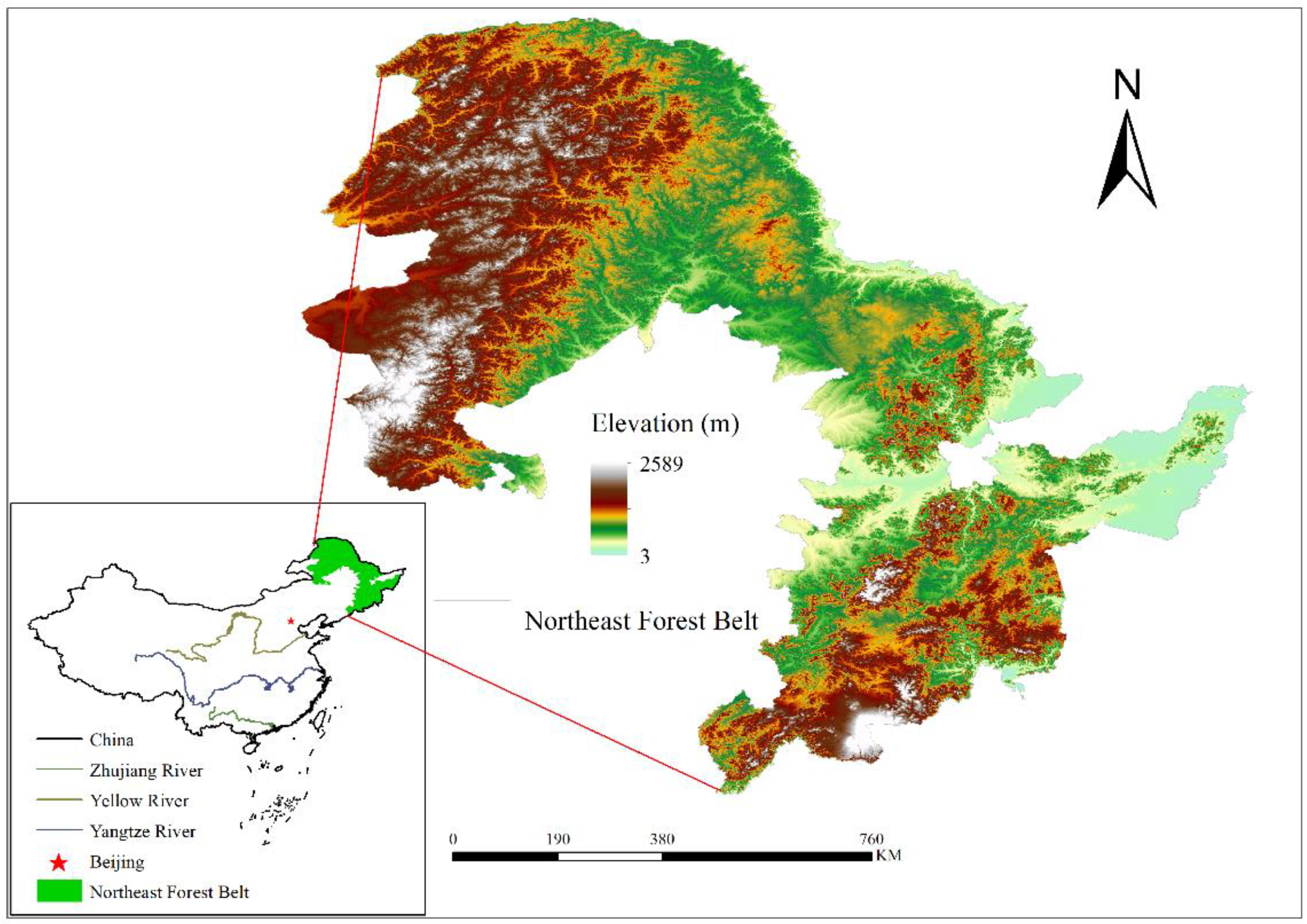
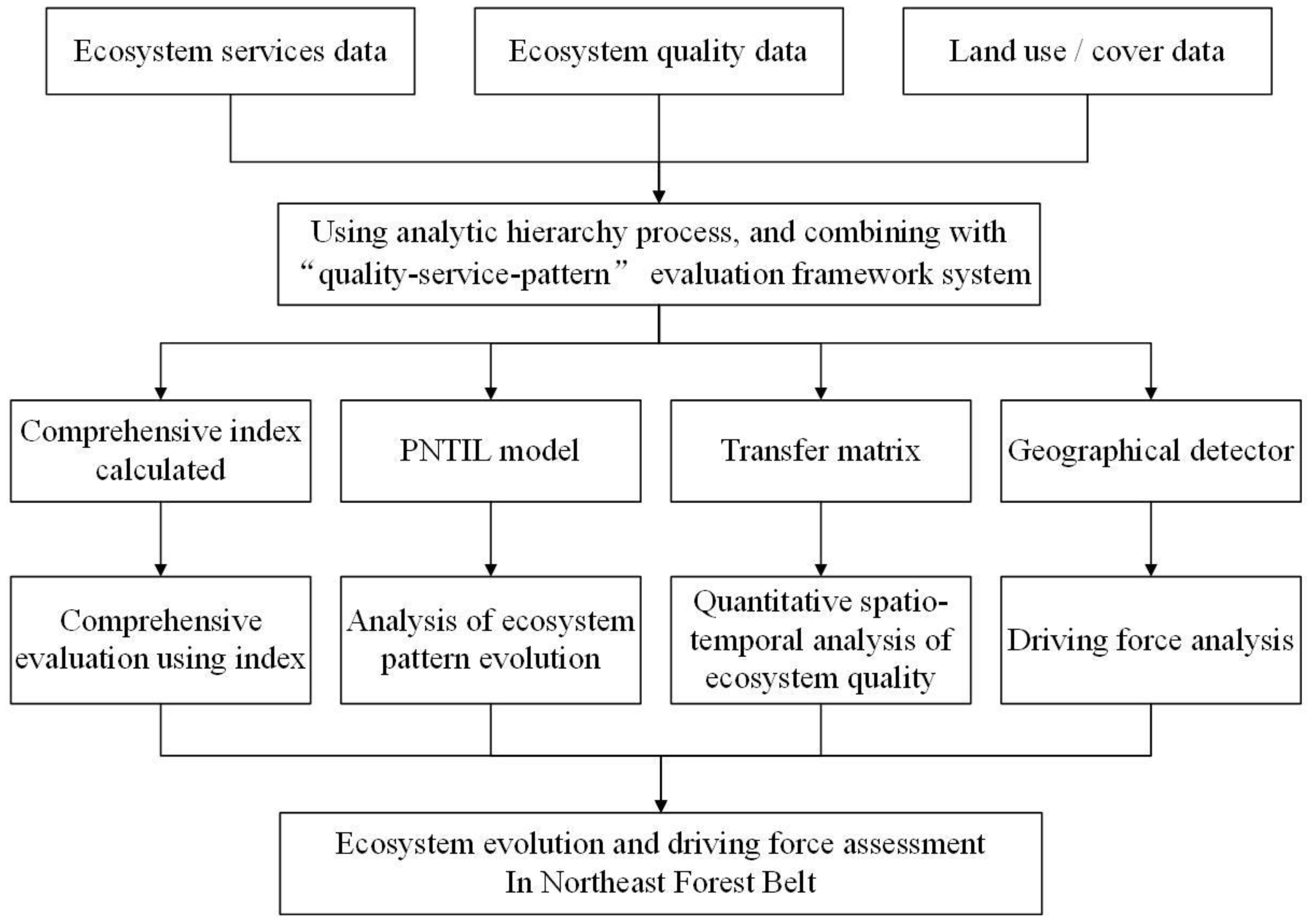

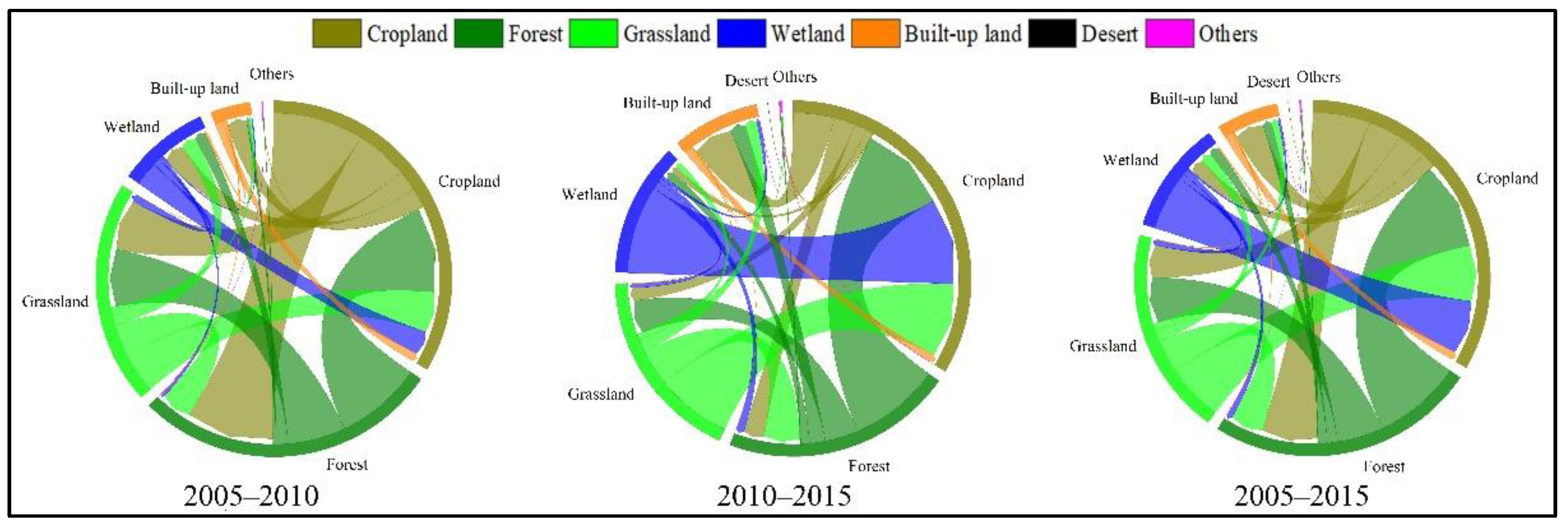
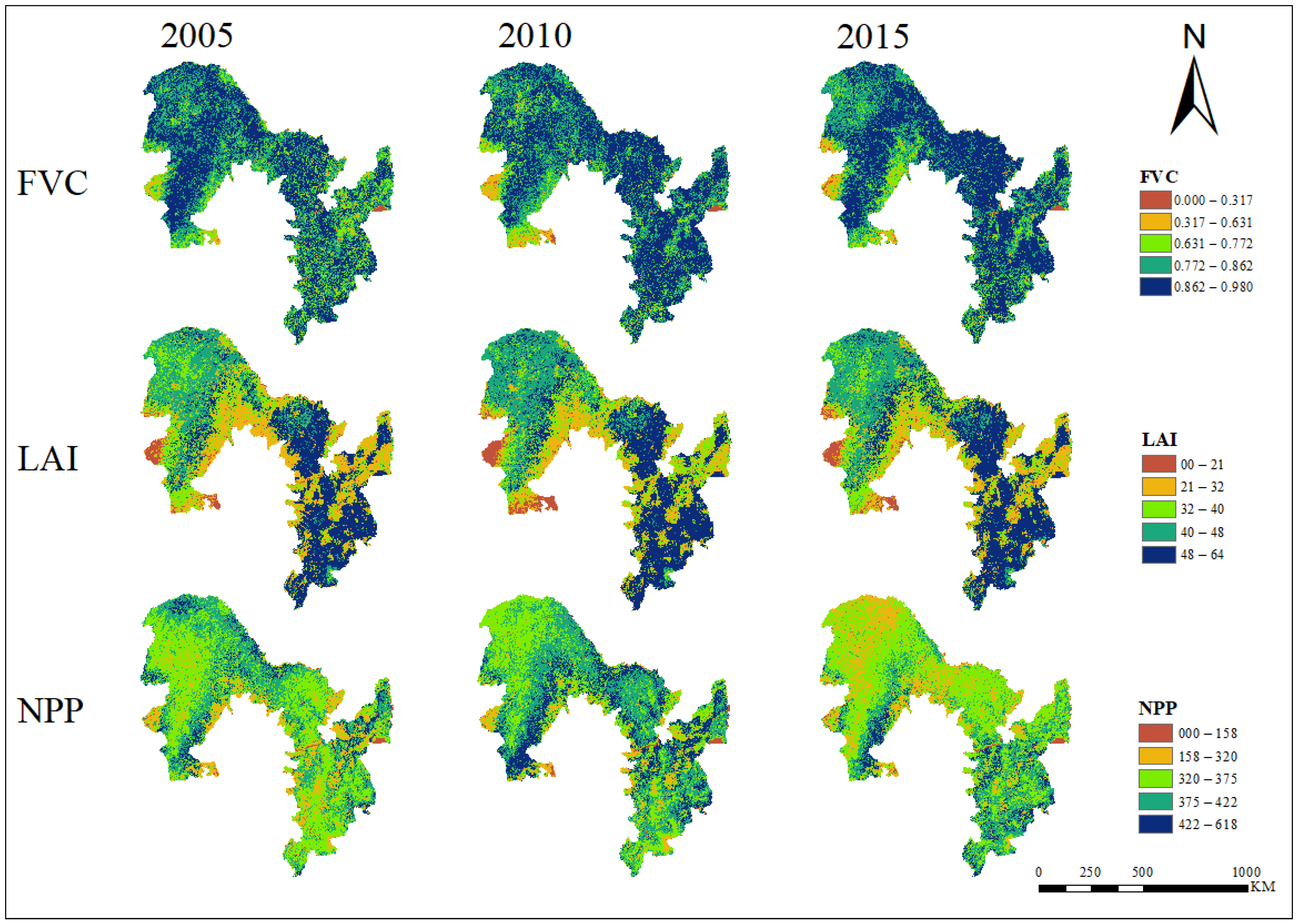
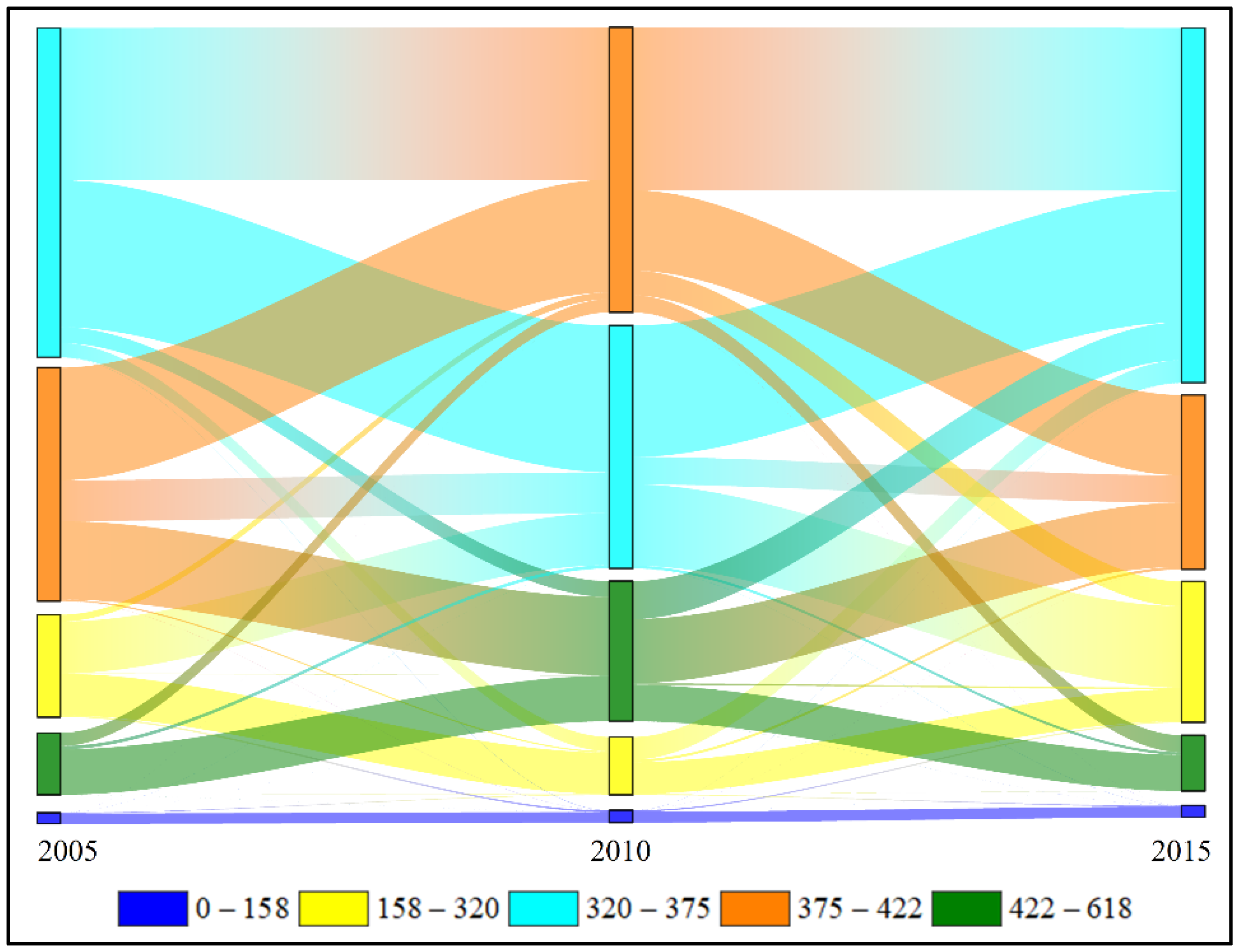
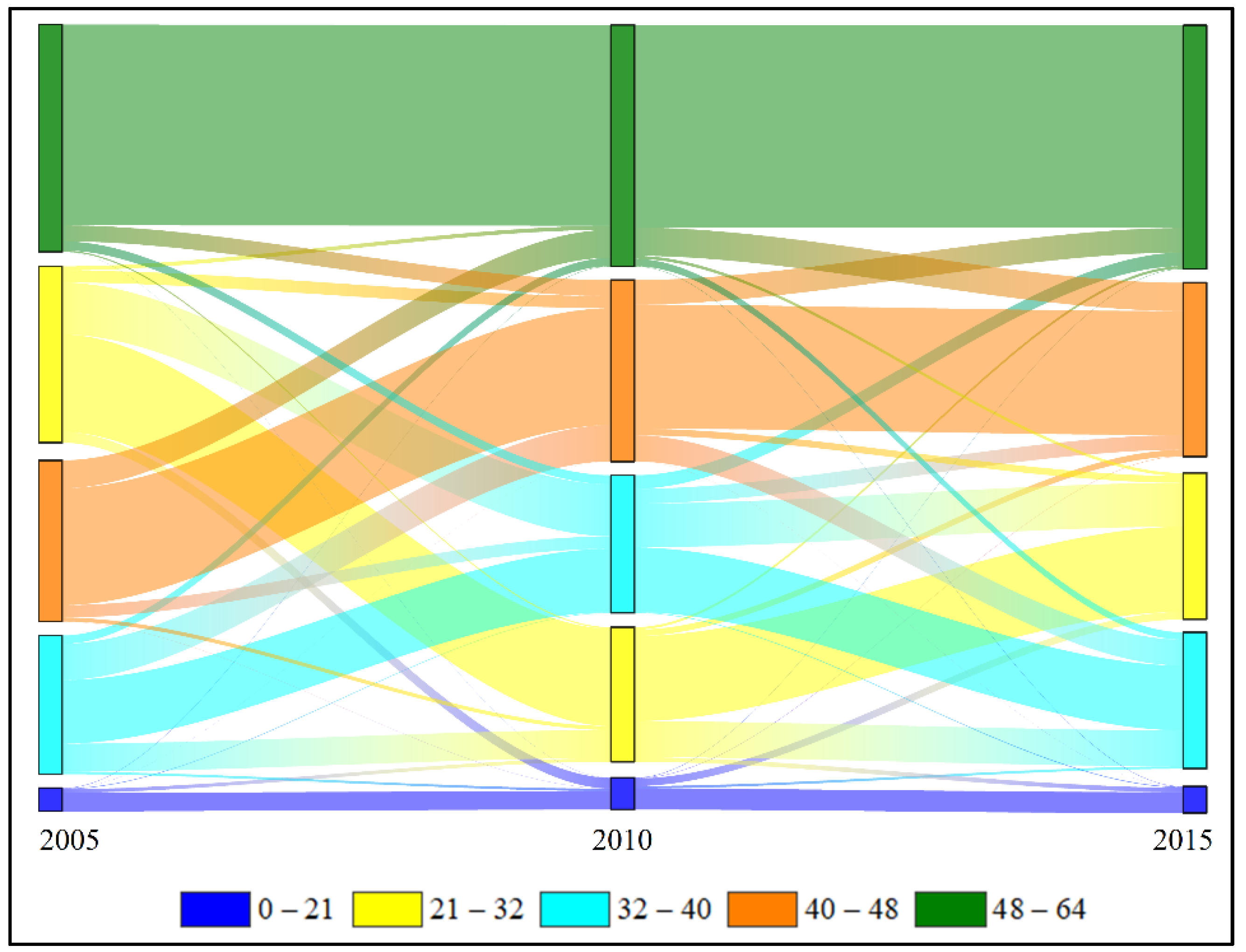
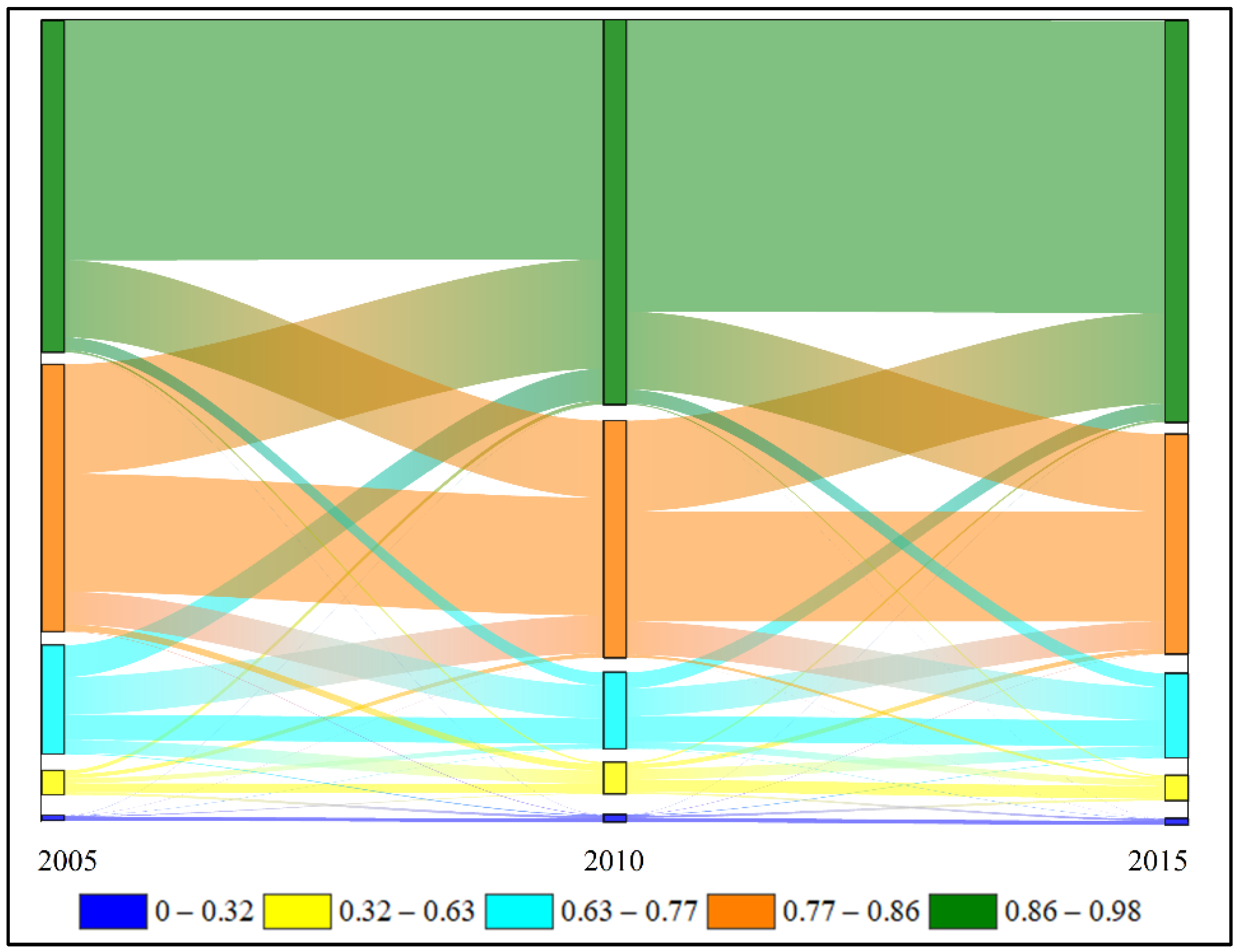


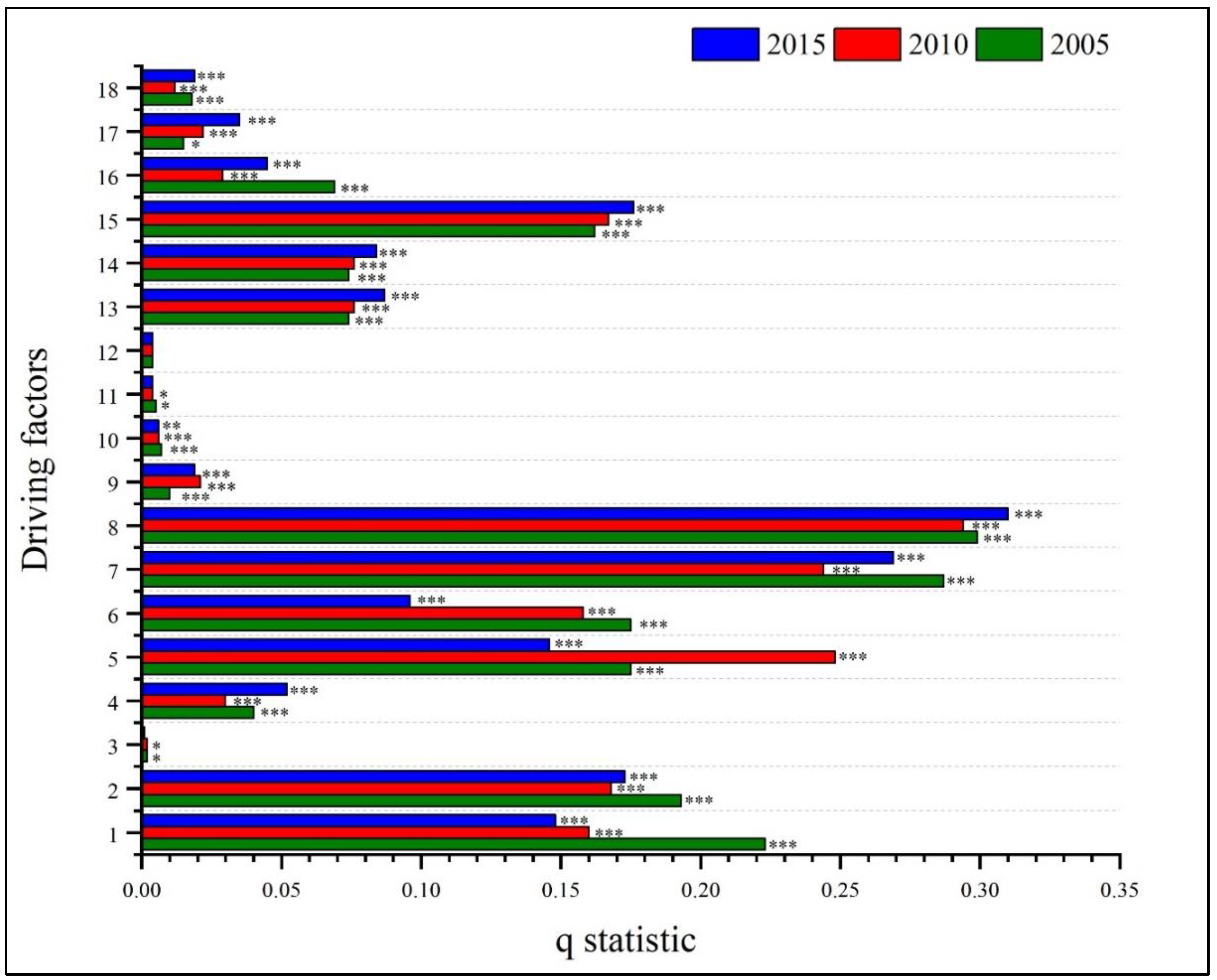
| Goal Layer | Labeling Layer | Indicator Layer | Unit | Property | Weight |
|---|---|---|---|---|---|
| Comprehensive Index | Ecosystem service | SSS | t/(km2·a) | + | 0.0337 |
| SCS | t/(km2·a) | + | 0.0531 | ||
| WCS | t/(km2·a) | + | 0.1415 | ||
| C | t/(km2·a) | + | 0.2251 | ||
| HP | - | + | 0.0867 | ||
| Ecosystem quality | FVC | % | + | 0.1623 | |
| NPP | gc/m2 | + | 0.0537 | ||
| LAI | - | + | 0.0809 | ||
| Ecosystem pattern | LULC | - | + | 0.1630 |
| Hierarchical Model | Judgment Matrix | Consistency Test | ||||||
|---|---|---|---|---|---|---|---|---|
| A–B | A | B1 | B2 | B3 | Wi | CR = 0.052 λmax = 3.054 | ||
| B1 | 1 | 1/3 | 2 | 0.2969 | ||||
| B2 | 3 | 1 | 3 | 0.5401 | ||||
| B3 | 1/2 | 1/3 | 1 | 0.1630 | ||||
| B1–C | B1 | C1 | C2 | C3 | Wi | CR = 0.009 λmax = 3.009 | ||
| C1 | 1 | 3 | 2 | 0.5466 | ||||
| C2 | 1/3 | 1 | 1/2 | 0.1810 | ||||
| C3 | 1/2 | 2 | 1 | 0.2724 | ||||
| B2–C | B2 | C4 | C5 | C6 | C7 | C8 | Wi | CR = 0.015 λmax = 5.068 |
| C4 | 1 | 3 | 4 | 1/2 | 2 | 0.2620 | ||
| C5 | 1/3 | 1 | 2 | 1/4 | 1/4 | 0.0984 | ||
| C6 | 1/4 | 1/2 | 1 | 1/5 | 1/3 | 0.0623 | ||
| C7 | 2 | 4 | 5 | 1 | 3 | 0.4167 | ||
| C8 | 1/2 | 2 | 3 | 1/3 | 1 | 0.1606 | ||
| Ecosystem Type | Types after Conversion | Conversion Direction |
|---|---|---|
| Forest (I) | III | + |
| II, IV, V, VI, VII | - | |
| Grassland (II) | I, III | + |
| IV, V, VI, VII | - | |
| Wetland (III) | - | + |
| I, II, IV, V, VI, VII | - | |
| Cropland (IV) | I, II, III | + |
| V, VI, VII | - | |
| Built-up land (V) | I, II, III, IV | + |
| VI, VII | - | |
| Desert (VI) | I, II, III, IV, V, VII | + |
| - | - | |
| Others (VII) | I, II, III, IV, V | + |
| VI | - |
| Ecosystem Pattern | 2005 | 2010 | 2015 | |||
|---|---|---|---|---|---|---|
| Area (km2) | Percent (%) | Area (km2) | Percent (%) | Area (km2) | Percent (%) | |
| Forest | 110,260 | 17.92 | 110,164 | 17.90 | 110,838 | 18.01 |
| Grassland | 391,951 | 63.68 | 391,810 | 63.66 | 391,497 | 63.61 |
| Wetland | 80,262 | 13.04 | 80,377 | 13.06 | 80,080 | 13.01 |
| Cropland | 26,738 | 4.34 | 26,799 | 4.35 | 26,492 | 4.30 |
| Built-up land | 5607 | 0.91 | 5665 | 0.92 | 5900 | 0.96 |
| Desert | 172 | 0.03 | 172 | 0.03 | 173 | 0.03 |
| Others | 468 | 0.08 | 471 | 0.08 | 478 | 0.08 |
| Total amount | 615,458 | 100 | 615,458 | 100 | 615,458 | 100 |
| Year. | Transformation Direction | Cropland | Forest | Grassland | Wetland | Built-Up Land | Desert | Others |
|---|---|---|---|---|---|---|---|---|
| 2005–2010 | TFR | 0.124 | 0.003 | 0.049 | 0.000 | 0.178 | 0.000 | 0.043 |
| RFR | 0.015 | 0.032 | 0.046 | 0.113 | 0.000 | 0.000 | 0.000 | |
| 2010–2015 | TFR | 0.027 | 0.002 | 0.039 | 0.000 | 0.124 | 0.000 | 0.085 |
| RFR | 0.029 | 0.027 | 0.082 | 0.288 | 0.000 | 0.000 | 0.000 |
| Year | NPP Level | Poor (km2) | Fair (km2) | Middle (km2) | Good (km2) | Excellent (km2) |
|---|---|---|---|---|---|---|
| 2005–2010 | Poor | 592 | 45 | 14 | 4 | |
| Fair | 1338 | 43,274 | 5649 | 334 | ||
| Middle | 199 | 11,871 | 127,125 | 13,196 | ||
| Good | 79 | 1157 | 34,089 | 65,354 | ||
| Excellent | 11 | 199 | 2762 | 10,975 | ||
| 2010–2015 | Poor | 1130 | 96 | 34 | 3 | |
| Fair | 745 | 18,869 | 2133 | 123 | ||
| Middle | 112 | 67,789 | 22,850 | 2184 | ||
| Good | 39 | 20,709 | 135,889 | 14,126 | ||
| Excellent | 33 | 1393 | 31,646 | 53,501 | ||
| 2005–2015 | Poor | 766 | 80 | 25 | 3 | |
| Fair | 1111 | 38,243 | 6113 | 764 | ||
| Middle | 236 | 53,261 | 57,227 | 8878 | ||
| Good | 127 | 22,224 | 89,167 | 21,390 | ||
| Excellent | 38 | 2355 | 13,456 | 20,382 |
| Year | LAI Level | Poor (km2) | Fair (km2) | Middle (km2) | Good (km2) | Excellent (km2) |
|---|---|---|---|---|---|---|
| 2005–2010 | Poor | 3037.25 | 534.50 | 72.00 | 383.25 | |
| Fair | 9115.00 | 44,022.50 | 10,289.75 | 3443.00 | ||
| Middle | 2052.00 | 23,814.50 | 30,719.25 | 7123.00 | ||
| Good | 159.00 | 3325.25 | 10,524.75 | 23,651.75 | ||
| Excellent | 113.50 | 1179.75 | 7669.50 | 13,580.00 | ||
| 2010–2015 | Poor | 6478.25 | 2084.50 | 381.00 | 387.75 | |
| Fair | 3873.50 | 30,428.50 | 5348.50 | 2170.00 | ||
| Middle | 644.50 | 37,092.00 | 12,495.75 | 11,521.75 | ||
| Good | 77.50 | 5725.00 | 22,008.25 | 20,833.25 | ||
| Excellent | 338.25 | 2606.00 | 6227.00 | 23,994.50 | ||
| 2005–2015 | Poor | 3700.25 | 877.75 | 193.50 | 465.75 | |
| Fair | 6822.00 | 39,639.50 | 11,397.50 | 4577.00 | ||
| Middle | 1096.50 | 27,113.00 | 23,052.25 | 11,783.50 | ||
| Good | 226.50 | 4274.25 | 13,668.00 | 21,271.25 | ||
| Excellent | 107.00 | 1915.75 | 6896.75 | 15,372.75 |
| Year | FVC Level | Poor (km2) | Fair (km2) | Middle (km2) | Good (km2) | Excellent (km2) |
|---|---|---|---|---|---|---|
| 2005–2010 | Poor | 811.75 | 230.75 | 126.75 | 157.25 | |
| Fair | 2063.50 | 4124.00 | 3458.75 | 3274.50 | ||
| Middle | 761.50 | 11,163.50 | 31,493.50 | 26,591.25 | ||
| Good | 438.25 | 5585.00 | 27,511.75 | 91,299.25 | ||
| Excellent | 126.00 | 1643.50 | 10,801.25 | 64,285.25 | ||
| 2010–2015 | Poor | 1970.75 | 545.00 | 318.50 | 149.25 | |
| Fair | 1698.75 | 9140.25 | 3963.25 | 1783.00 | ||
| Middle | 273.75 | 5699.75 | 22,891.00 | 13,337.00 | ||
| Good | 73.75 | 2252.25 | 27,844.25 | 76,032.50 | ||
| Excellent | 47.00 | 1069.25 | 11,636.00 | 64,940.00 | ||
| 2005–2015 | Poor | 937.00 | 256.75 | 152.50 | 178.25 | |
| Fair | 1929.00 | 4743.50 | 3284.75 | 3353.25 | ||
| Middle | 534.00 | 8397.75 | 29,159.75 | 27,175.25 | ||
| Good | 184.75 | 3720.50 | 31,297.00 | 93,027.75 | ||
| Excellent | 49.25 | 945.00 | 8591.50 | 56,073.00 |
| Comprehensive Index Level | 2005 | 2010 | 2015 | |||
|---|---|---|---|---|---|---|
| Area (km2) | Percent (%) | Area (km2) | Percent (%) | Area (km2) | Percent (%) | |
| Poor (0.013–0.262) | 33,456 | 5.21 | 45,326 | 7.06 | 27,521 | 4.29 |
| Fair (0.262–0.333) | 131,000 | 20.40 | 132,402 | 20.62 | 118,302 | 18.42 |
| Middle (0.333–0.399) | 177,052 | 27.57 | 174,635 | 27.19 | 147,437 | 22.96 |
| Good (0.399–0.471) | 229,065 | 35.67 | 223,391 | 34.78 | 230,204 | 35.85 |
| Excellent (0.471–0.746) | 71,641 | 11.16 | 66,460 | 10.35 | 118,750 | 18.49 |
| Total amount | 642,214 | 100 | 642,214 | 100 | 642,214 | 100 |
Publisher’s Note: MDPI stays neutral with regard to jurisdictional claims in published maps and institutional affiliations. |
© 2022 by the authors. Licensee MDPI, Basel, Switzerland. This article is an open access article distributed under the terms and conditions of the Creative Commons Attribution (CC BY) license (https://creativecommons.org/licenses/by/4.0/).
Share and Cite
Liao, Z.; Su, K.; Jiang, X.; Zhou, X.; Yu, Z.; Chen, Z.; Wei, C.; Zhang, Y.; Wang, L. Ecosystem and Driving Force Evaluation of Northeast Forest Belt. Land 2022, 11, 1306. https://doi.org/10.3390/land11081306
Liao Z, Su K, Jiang X, Zhou X, Yu Z, Chen Z, Wei C, Zhang Y, Wang L. Ecosystem and Driving Force Evaluation of Northeast Forest Belt. Land. 2022; 11(8):1306. https://doi.org/10.3390/land11081306
Chicago/Turabian StyleLiao, Zhihong, Kai Su, Xuebing Jiang, Xiangbei Zhou, Zhu Yu, Zhongchao Chen, Changwen Wei, Yiming Zhang, and Luying Wang. 2022. "Ecosystem and Driving Force Evaluation of Northeast Forest Belt" Land 11, no. 8: 1306. https://doi.org/10.3390/land11081306
APA StyleLiao, Z., Su, K., Jiang, X., Zhou, X., Yu, Z., Chen, Z., Wei, C., Zhang, Y., & Wang, L. (2022). Ecosystem and Driving Force Evaluation of Northeast Forest Belt. Land, 11(8), 1306. https://doi.org/10.3390/land11081306






